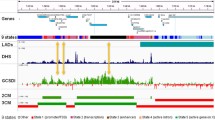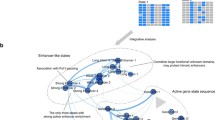Abstract
A number of chromatin characteristics of exon regions have been revealed by analysis of chromatin modifications. The distribution of histone modifications in exon regions greatly varies among cell types. The correlation of the rate of alternative splicing with a certain chromatin type has been analyzed, and its most characteristic types have been identified. The distribution of chromatin labels in the DScam gene, which produces an enormous number of transcripts, assessed at 38000, is presented as an example. It is concluded that this gene undergoes integrated regulation by the chromatin state at the levels of domains and exons.
Similar content being viewed by others
References
Alexander, R. and Beggs, J.D., Cross-Talk in Transcription, Splicing and Chromatin: Who Makes the First Call?, Biochem. Soc. Trans., 2010, vol. 38, no. 5, pp. 1251–1256.
Andersson, R., Enroth, S., Rada-Iglesias, A., et al., Nucleosomes Are Well Positioned in Exons and Carry Characteristic Histone Modifications, Genome Res., 2009, vol. 9, no. 10, pp. 1732–1741.
Babenko, V.N., Makunin, I.V., Brusentsova, I.V., et al., Paucity and Preferential Suppression of Transgenes in Late Replication Domains of the D. melanogaster Genome, BMC Genomics, 2010, vol. 11, p. 318.
Barash, Y., Calarco, J.A., Gao, W., et al., Deciphering the Splicing Code, Nature, 2010, vol. 465, no. 7294, pp. 53–59.
Berget, S.M., Exon Recognition in Vertebrate Splicing, J. Biol. Chem., 1995, vol. 270, no. 6, pp. 2411–2414.
Celniker, S.E., Dillon, L.A., Gerstein, M.B., et al., ModENCODE Consortium. Unlocking the Secrets of the Genome, Nature, 2009, vol. 459, no. 7249, pp. 927–930.
Fujita, P.A., Rhead, B., Zweig, A.S., et al., The UCSC Genome Browser Database, Nucleic Acids Res., 2011, vol. 39 (database issue), pp. D876–D882.
Graveley, B.R., Mutually Exclusive Splicing of the Insect Dscam pre-MRNA Directed by Competing Intronic RNA Secondary Structures, Cell, 2005, vol. 123, no. 1, pp. 65–73.
Graveley, B.R., Brooks, A.N., Carlson, J.W., et al., The Developmental Transcriptome of Drosophila melanogaster, Nature, 2011, vol. 471, no. 7339, pp. 473–479.
Gunderson, F.Q. and Johnson, T.L., Acetylation by the Transcriptional Coactivator Gcn5 Plays a Novel Role in Co-Transcriptional Spliceosome Assembly, PLoS Genet, 2009, vol. 5, p. e1000682.
Guo, J., Garrett, M., Micklem, G., and Brogna, S., Poly(A) Signals Located Near the 5’ End of Genes Are Silenced by a General Mechanism that Prevents Premature 3’ End Processing, Mol. Cell. Biol., 2011, vol. 31, no. 4, pp. 639–651.
Hansen, K.D., Lareau, L.F., Blanchette, M., et al., Genome-Wide Identification of Alternative Splice Forms Down-Regulated by Nonsense-Mediated MRNA Decay in Drosophila, PLoS Genet., 2009, vol. 5, no. 6, p. e1000525.
Huff, J.T., Plocik, A.M., Guthrie, C., and Yamamoto, K.R., Reciprocal Intronic and Exonic Histone Modification Regions in Humans, Nat. Struct. Mol. Biol., 2010, vol. 17, no. 12, pp. 1495–1499.
Khaladkar, M., Smyda, M., and Hannenhalli, S., Epigenomic and RNA Structural Correlates of Polyadenylation, RNA Biol., 2011, vol. 8, no. 3, pp. 1–9.
Kharchenko, P.V., Alekseyenko, A.A., Schwartz, Y.B., et al., Comprehensive Analysis of the Chromatin Landscape in Drosophila melanogaster, Nature, 2011, vol. 471, no. 7339, pp. 480–485.
Lee, B.T., Tan, T.W., and Ranganathan, S., DEDB: a Database of Drosophila melanogaster Exons in Splicing Graph Form, BMC Bioinformatics, 2004, vol. 5, p. 189.
Li, S. and Shogren-Knaak, M.A., The Gcn5 Bromodomain of the SAGA Complex Facilitates Cooperative and Cross-Tail Acetylation of Nucleosomes, J. Biol. Chem., 2009, vol. 284, pp. 9411–9417.
Loomis, R.J., Naoe, Y., Parker, J.B., et al., Chromatin Bin-Ding of SRp20 and ASF/SF2 and Dissociation from Mitotic Chromosomes Is Modulated Byhistone H3 Serine 10 Phosphorylation, Mol. Cell, 2009, vol. 33, no. 4, pp. 450–461.
Luco, R.F., Pan, Q., Tominaga, K., et al., Regulation of Alternative Splicing by Histone Modifications, Science, 2010, vol. 327, no. 5968, pp. 996–1000.
May, G.E., Olson, S., McManus, C.J., and Graveley, B.R., Competing RNA Secondary Structures Are Required for Mutually Exclusive Splicing of the Dscam Exon 6 Cluster, RNA, 2011, vol. 17, no. 2, pp. 222–229.
Morillon, A. and Karabetsou, N., O’sullivan J. et al. Isw1 Chromatin Remodeling ATPase Coordinates Transcription Elongation and Termination by RNA Polymerase II, Cell, 2003, vol. 115, pp. 425–435.
Nahkuri, S., Taft, R.J., and Mattick, J.S., Nucleosomes Are Preferentially Positioned at Exons in Somatic and Sperm Cells, Cell Cycle, 2009, vol. 8, pp. 3420–3424.
Patraquim, P., Warnefors, M., and Alonso, C.R., Evolution of Hox Posttranscriptional Regulation by Alternative Polyadenylation and microRNA Modulation within Twelve Drosophila Genomes, Mol. Biol. Evol., 2011 (in press).
Piacentini, L., Fanti, L., Negri, R., et al., Heterochromatin Protein 1 (HP1a) Positively Regulates Euchromatic Gene Expression through RNA Transcript Association and Interaction with hnRNPs in Drosophila, PLoS Genet., 2009, vol. 5, no. 10, p. e1000670.
Pray-Grant, M.G., Daniel, J.A., Schieltz, D., et al., Chd1 Chromodomain Links Histone H3 Methylation with SAGA- and SLIK-Dependent Acetylation, Nature, 2005, vol. 433, pp. 434–438.
Roy, S., Ernst, J., Kharchenko, P.V., et al., The modEN-CODE Consortium. Identification of Functional Elements and Regulatory Circuits by Drosophila ModEN-CODE, Science, 2010, vol. 330, no. 6012, pp. 1787–1797.
Schneider, M., Will, C.L., Anokhina, M., et al., Exon Definition Complexes Contain the Tri-snRNP and Can Be Directly Converted into B-Like Precatalytic Splicing Complexes, Mol. Cell, 2010, vol. 38, no. 2, pp. 223–235.
Schwartz, S., Meshorer, E., and Ast, G., Chromatin Organization Marks Exon-Intron Structure, Nat. Struct. Mol. Biol., 2009, vol. 16, no. 9, pp. 990–995.
Shabalina, S.A., Spiridonov, A.N., Spiridonov, N.A., and Koonin, E.V., Connections between Alternative Transcription and Alternative Splicing in Mammals, Genome Biol. Evol., 2010, vol. 2, pp. 791–799.
Sims, R.J., Millhouse, S., Chen, C.F., et al., Recognition of Trimethylated Histone H3 Lysine 4 Facilitates the Recruitment of Transcription Postinitiation Factors and pre-mRNA Splicing, Mol. Cell, 2007, vol. 28, pp. 665–676.
Spies, N., Nielsen, C.B., Padgett, R.A., and Burge, C.B., Biased Chromatin Signatures around Polyadenylation Sites and Exons, Mol. Cell, 2009, vol. 36, no. 2, pp. 245–254.
Tilgner, H., Nikolaou, C., Althammer, S., et al., Nucleosome Positioning as a Determinant of Exon Recognition, Nat. Struct. Mol. Biol., 2009, vol. 16, no. 9, pp. 996–1001.
Author information
Authors and Affiliations
Corresponding author
Additional information
Original Russian Text © V.N. Babenko, V.F. Matvienko, I.A. Zykov, 2011, published in Vavilovskii Zhurnal Genetiki i Selektsii, 2011, Vol. 15, No. 3, pp. 579–594.
Rights and permissions
About this article
Cite this article
Babenko, V.N., Matvienko, V.F. & Zykov, I.A. Drosophila melanogaster genome: Correlation of chromatin state with splicing and transcription regulation. Russ J Genet Appl Res 2, 85–96 (2012). https://doi.org/10.1134/S2079059712010029
Published:
Issue Date:
DOI: https://doi.org/10.1134/S2079059712010029




